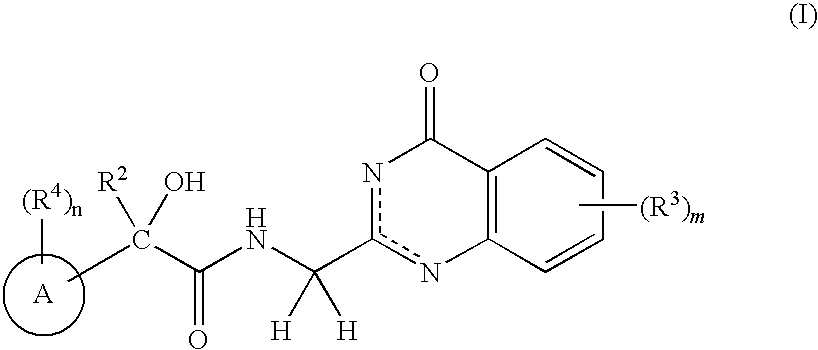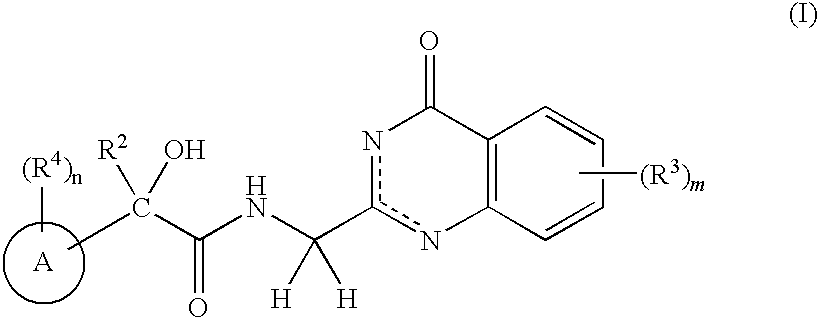N-(4-Oxo-3,4-Dihydroquinazolin-2Yl) Butanamides as Androgen Receptor Modulators
a technology of androgen receptor and butanamide, which is applied in the direction of depsipeptides, organic active ingredients, peptide/protein ingredients, etc., can solve the problems of men's hot flushes, significant bone loss, fatigue, etc., to stimulate muscle growth, reduce skin irritation, and reduce the effect of sarcopenia and frailty
- Summary
- Abstract
- Description
- Claims
- Application Information
AI Technical Summary
Benefits of technology
Problems solved by technology
Method used
Image
Examples
example 1
[0252]Scheme 1 depicts the synthesis of the quinazolinone alkylamine coupling compound, 1-e, used in the synthesis of compounds of the present invention.
[0253]A solution of phthalylglycyl chloride (1-a, 5.0 g, 22.4 mmol) in THF (15 mL) was added to a solution of anthranyl amide (1-b, R3═H, 3.04 g, 22.3 mmol) and triethylamine (3.74 mL, 26.8 mmol) in THF (45 mL). The reaction mixture was stirred overnight, and the precipitates (1-c, R3═H) were collected by filtration, washed with water and dried (1-c, R3═H, 6.28 g, 87%). The product (1-C, R3═H) was suspended in diphenylether was heated by the microwave at 220 C for 1 h. The precipitates were collected by filtration, washed with ether and dried under the reduced pressure (1-d, R3═H); HRMS (M+1)=306.0870; 1H NMR (500 MHz, DMSO-d6) δ 12.53 (s, 1H), 8.09 (d, 1H, J=8.0 Hz), 7.97-7.94 (m, 2H), 7.92-7.90 (m, 2H), 7.73 (t, 1H, J=7.2 Hz), 7.48 (t, 1H, J=7.5 Hz), 7.45 (d, 1H, J=8.0 Hz), 4.78 (s, 2H).
Step C (4-oxo-3,4-dihydroquinazolin-2-yl)met...
example 2
[0255]Scheme 2 depicts the alternative synthesis routes for the phenylcarbonyl coupling unit, 2-e, used in the synthesis of compounds of the present invention.
[0256]The carboxylic acid moieties used to form Examples 1-1 and 1-2 in Table 1 were prepared from 2-a (R1═H) as shown in Scheme 2 by a known method (Mosher, H. S., et al., J. Org. Chem. 1969, 34, 2543). Resolution of the enantiomeric mixture of the ester was carried out with the ChiralPack AD [360 nm, 95% Hexanes (0.1% diethylamine) and 5% MeOH / Et0H (1:1)] instead of the fractional crystallization of the acid as reported in the literature. The absolute configuration of (2R)-3,3,3-trifluoro-2-hydroxy-2-phenylpropanoic acid (2-e with R1═H and R2═CF3) was determined to be R (measured [α]p, +24.8, c 0.1, MeOH; literature [α]D+29.8, c 0.8, MeOH, Sharpless, K. B. et al., Tetrahedron: Asymmetry 1994, 5, 1473). The absolute configuration of resolved 3,3,4,4,4-pentafluoro-2-hydroxy-2-phenylbutanoic acid has not been established. Under...
example 3
[0259]Scheme 3 depicts the final coupling step in order to form the compounds of present invention.
Ex. 3-1 (2R)-3,3,3-trifluoro-2-hydroxy-N-[(4-oxo-3,4-dihydroquinazolin-2-yl)methyl]-2-phenylpropanamide (1-1)
[0260]
[0261]A solution of (2R)-3,3,3-trifluoro-2-hydroxy-2-phenylpropanoic acid (100 mg, 0.45 mmol)(2-e, R1═H; R2═CF3) (4-oxo-3,4-dihydroquinazolin-2-yl)methanaminium chloride (1-e, R3═H, 88 mg, 0.50 mmol), 1-hydroxybenzotriazole (HOBT, 74 mg, 0.545 mmol), and diisopropylethylamine (149 uL, 0.91 mmol) in N,N-dimethylformamide (2 mL) was treated at room temperature with 1-(3-Dimethylaminopropyl)-3-ethylcarbodiimede hydrochloride (EDC, 104 mg, 0.545 mmol). The reaction mixture was stirred for 15 hours at room temperature. The solvent was removed in vacuo and the residue was partitioned between ethyl acetate and water. The organic layer was then washed with 1.0 N-NaOH twice and the basic aqueous layer was placed into an ice bath to facilitate crystallization. The solid was filtered...
PUM
| Property | Measurement | Unit |
|---|---|---|
| pH | aaaaa | aaaaa |
| pH | aaaaa | aaaaa |
| pH | aaaaa | aaaaa |
Abstract
Description
Claims
Application Information
 Login to View More
Login to View More - R&D
- Intellectual Property
- Life Sciences
- Materials
- Tech Scout
- Unparalleled Data Quality
- Higher Quality Content
- 60% Fewer Hallucinations
Browse by: Latest US Patents, China's latest patents, Technical Efficacy Thesaurus, Application Domain, Technology Topic, Popular Technical Reports.
© 2025 PatSnap. All rights reserved.Legal|Privacy policy|Modern Slavery Act Transparency Statement|Sitemap|About US| Contact US: help@patsnap.com



